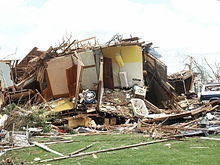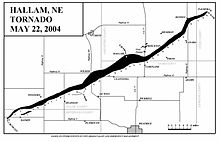 Tornado damage in Hallam Tornado damage in Hallam | |
| Meteorological history | |
|---|---|
| Formed | May 22, 2004 7:30 PM CDT |
| Dissipated | May 22, 2004 9:10 PM CDT |
| Duration | 1 hour and 40 minutes |
| F4 tornado | |
| on the Fujita scale | |
| Highest winds | 207–260 mph (333–418 km/h) |
| Overall effects | |
| Fatalities | 1 |
| Injuries | 38 |
| Damage | $160 million (2004 USD) |
| Areas affected | Nebraska (Jefferson, Saline, Gage, Lancaster, and Otoe counties) |
Part of the Tornado outbreak sequence of May 2004 and tornado outbreaks of 2004 | |
During the afternoon of May 22, 2004, a long-track F4 tornado formed during a tornado outbreak and tore through multiple counties in southeast Nebraska. The tornado damaged many towns along its path, but its most significant destructive effect occurred at the town of Hallam. The Hallam tornado is recognized by NOAA as the second-largest tornado on record, peaking at 2.5 miles (4.0 km) wide at Hallam, behind only the 2013 El Reno tornado.
Tornado sequence


The Hallam tornado formed west and northwest of Daykin at 7:30 pm CDT at an F1 intensity on the Fujita Scale. One satellite tornado, rated F1, formed and quickly dissipated northeast of town. The main storm turned and traveled east-northeast from Daykin to a point south-southeast of Western and then to about 2 miles (3.2 km) north of Swanton. During this time, the tornado fluctuated between F0 and F1 in intensity, damaging farmhouses and silos. The tornado remained confined within the F0-F1 range until it hit southern Wilber, where it intensified to F2 strength and blew roofs off of structures. The tornado continued east-northeast, grazing the east side of Wilber as it moved towards Clatonia. Here it is estimated that the tornado reached F3 strength.
After passing just northwest of Clatonia, the tornado became violent and moved through Hallam at 8:35 pm CDT, where damage reached high-end F4 in intensity. At Hallam, the tornado was a record-breaking 2.5 miles (4.0 km) wide, making it the widest tornado ever recorded at the time. Most houses in Hallam were completely demolished, along with farming equipment and other structures. A coal train was tossed off its tracks on the west side of town. Hallam escaped the most intense winds of the storm though, which were to the south. East of Hallam, damage was rated F2-F3 as the tornado turned east and began to cycle with a new circulation forming within the storm to the south of the tornado. It decreased in size to about 1 mile (1.6 km) as it passed north of Cortland, where it turned northeast and passed 2 miles (3.2 km) north of Firth. Norris School District 160 suffered severe damage, with the middle school being hit the worst. The auditorium roof and other walls within the school caved in. Buses were tossed and homes northeast of the school were flattened.
The tornado then reached F4 intensity again as it continued northeast to Holland before weakening again as it passed north-northwest of Panama, where mostly F1 and F2 damage was observed. The tornado then tracked north-northeast to Bennet, where some houses received F3 damage. At Bennet, the tornado turned east-northeast and began to thin out. Damage east-northeast of Bennet was in the F0-F1 range. The tornado finally dissipated a mile west-southwest of Palmyra at 9:10 pm CDT.
Damage
The storm was long-lived, having been on the ground for more than 100 minutes. It was also a long-track tornado, having covered 52 miles (84 km). Even though it damaged towns and demolished many buildings, there were no damage-cost estimates available. The Hallam tornado became the widest on record until it was surpassed on May 31, 2013, by the El Reno, Oklahoma tornado, which had a width of 2.6 miles (4.2 km). Its width has since also been tied by the 2016 Jiangsu tornado. However, the Hallam tornado still holds the record for the largest condensation funnel recorded.
See also
Notes
- Long-track is defined as traversing 25 miles (40 km) or more.
- Width is tied with the 2016 Jiangsu tornado
References
- "The May 22nd, 2004 Tornado Outbreak". National Weather Service Hastings, Nebraska. National Oceanic and Atmospheric Administration, U.S. Dept of Commerce. Retrieved December 7, 2016.
- Smith, Brian E. (May 25, 2004). "Hallam Tornado May 2004 WFO Omaha Text Information (PNSOMA.0405252137)". National Weather Service Omaha/Valley, Nebraska. National Oceanic and Atmospheric Administration, U.S. Dept of Commerce. Retrieved December 7, 2016.
- "Hallam Nebraska Tornado May 2004". www.weather.gov. Retrieved 25 May 2022.
- "U.S. News: Breaking News Photos, & Videos on the United States".
- "Figure 1. Location and pathway of the Funing tornado, 23 June 2016. (A)".
- Zhiyong Meng; et al. (2018). "The Deadliest Tornado (EF4) in the Past 40 Years in China". Weather and Forecasting. 33 (3): 693–713. doi:10.1175/WAF-D-17-0085.1.
- "The Scale of Tornadoes". YouTube. RojoFern. Retrieved 2023-01-05.
External links
| Tornado outbreaks of 2004 | |
|---|---|